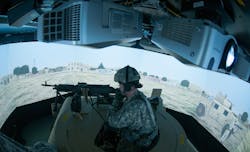DARPA asks industry for simulation technology to enable machine autonomy of unmanned ground vehicles
ARLINGTON, Va. – U.S. military researchers are asking industry to advance simulation technologies related to off-road machine autonomy to reduce the cost of developing off-road unmanned ground vehicles (UGVs) and bridge the gap from simulation to the real world.
Officials of the U.S. Defense Advanced Research projects Agency (DARPA) in Arlington, Va., issued a broad agency announcement (HR001121S0005) on Tuesday for the Robotic Autonomy in Complex Environments with Resiliency-Simulation (RACER-Sim) project.
RACER-Sim seeks to develop simulation technologies in simulation-based off-road autonomy algorithm development, simulation environment technologies, and simulation content generation.
This project is closely related to the DARPA RACER program to develop machine autonomy that enables unmanned ground combat vehicles to maneuver safely over rough off-road terrain at speeds a human driver could achieve.
Such a vehicle should be able to operate quickly over unstructured off-road terrain at speeds limited not by the autonomy software or processing time, but only by onboard sensor limitations, vehicle mechanical limits. Its speed should be similar to that of a human driver or a tele-operated vehicle.
Despite the commercial self-driving car industry making rapid advances in on-road autonomous mobility, military off-road autonomy algorithms and simulation capability development have lagged due to the complexity of the off-road problem, DARPA researchers explain.
While on-road simulations focus on well-structured and predictable environments with few obstacles, the military off-road environment is more challenging and complex, with 3D surfaces, dirt, mud, and vegetation, hundreds of obstacles, bad maps, continuous motion planning, and no defined road networks or driving rules.
The practical use of simulation in off-road robotics is limited because simulators are poor at modeling ground cover, broken terrain, and how ground vehicles can overcome vegetation obstacles.
The RACER-SIM project will last for four years and has two phases: simulation technologies risk reduction, and demonstrating the value of the simulation technologies.
Companies interested should submit proposals no later than 4 March 2021 to the DARPA BAA website at https://baa.darpa.mil. Email questions or concerns to DARPA at [email protected].
More information is online at https://beta.sam.gov/opp/22b4124168f342fb8a7fec18db037a52/view.

John Keller | Editor-in-Chief
John Keller is the Editor-in-Chief, Military & Aerospace Electronics Magazine--provides extensive coverage and analysis of enabling electronics and optoelectronic technologies in military, space and commercial aviation applications. John has been a member of the Military & Aerospace Electronics staff since 1989 and chief editor since 1995.

